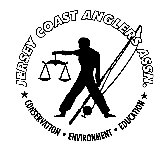 |
 |
|
|
||
Highly Migratory Species Report
by John T. Koegler






Highly Migratory Species Report
by John T. Koegler
(from Jersey Coast Anglers Association July 2001 Newsletter)
NMFS Adjusts Angling 2001 ABT limit to
4 bluefin between 27"-73"
Since the beginning of the new 2001 fishing year on June 1, the Atlantic bluefin tuna angling category daily retention limit has been one fish per vessel per trip. NMFS has determined that a retention limit adjustment is warranted to provide increased fishing and data collection opportunities in all areas without risking overharvest of the angling category quota. (Anglers caught few bluefin the last two years, so they have about 2 1/2 years of quota to catch, allowing more liberal rules for 2001).
Effective June 15 through October 31,
2001, NMFS adjusts the BFT angling category daily retention limit in all areas to FOUR
tuna per vessel measuring 27 to less than 763 inches curved fork length. The season will
stay open so that anglers can land their full allocated quota of bluefin tuna.
This has been defined by NMFS to
allow four bluefin of any size per trip, not just
school-sized fish. This is a major
change from previous years when only one larger bluefin between 47" and 73" was
permitted. This makes perfect sense since anglers have NEVER landed their quota of
47" plus tuna in any year. Last September NMFS transferred 60 Mt of angler category
47/73 inch bluefin tuna uncaught quota to the General Category. These new 2001 rules allow
anglers to target these larger fish and expect some reward for the much greater expense
required to find and try to catch these larger fish.
Effective November 1 until May 31,
2002, the angling daily limit is adjusted to one fish per vessel measuring 47 to less than
73 inches curved fork length.
All BFT landed under the Angling
category must be reported within 24 hours of landing to the NMFS automated catch reporting
system by calling 1-888-0872-8862. Remember your boat permit number and curved fork length
of each fish in inches is required. The smallest allowed is 27". This is hard to
determine sometimes. Smart skippers use a snap with 27" of heavy mono with the end
dyed or taped red. This makes it easier to closely determine the actual length of the tuna
without removing it from the water. Use a dehooker tool to release the fish in the best
possible condition.
New Highly Migratory Species Permit
Required for Charter/Headboat vessels
The Federal Office of Management and
Budget has approved a new permit class for vessels taking paying customers for Atlantic
tunas, swordfish, sharks and billfish. They must now obtain an Atlantic HMS
Charter/Headboat permit. This regulation is effective July 1, 2001. The 2001
Charter/Headboat HMS permit cost of $27.00 and will be valid from the date of issuance
through May 31, 2002. Eventually a daily report will be mandated for each trip for HMS
species by permitted vessels.
This requirement is a sad day for all
anglers. When angler quotas were originally set for
HMS species years ago,
Charter/Headboat HMS landings were generally left out of the data numbers reported to
ICCAT. This was done because including charter/headboats in the statistical count would
have greatly increased the angler ICCAT statistical estimate.
At that time NMFS program was to
allocate anglers the lowest possible BFT quota. They could not accomplish that objective
if the higher landing numbers from charter/headboats were counted. This new requirement
will eventually increase the number of tuna and marlin being counted without making any
adjustment or allowance to the original angler HMS quotas to cover these new reported
landings.
If ICCAT was a real and effective
international conservation organization one could understand NMFS's increased HMS
coverage. However, for all practical purposes ICCAT has failed to get their members to
comply with ANY of ICCAT's rules. In truth, ICCAT appears to be a failure. Only US, Japan
and Canada appear to be following their agreements. This is true even though these very
same ICCAT members approved and accepted these rules years ago. It is just when the
regulators face the politicians in each country they are unable to get the politician to
impose the rules the regulators have agreed to accept. ICCAT has no way to enforce their
rules since their rules are self-imposed by each nation.
Where
this leads other than to extinction of the tuna species is unknown but follows most
international failures to control the international sale of any high value wild species. At this time, bluefin tuna are worth more per
pound than any other wild species. The normal price for giant bluefin is over $10.00 per
pound with high quality tuna bring $20.00 per pound and a very few rare exceptional fish
bring $60/100 per pound. Consider that the average BFT weighs 500 pounds and it is not
difficult to understand the problem internationally.
NMFS is attempting to regulate US
imports of HMS species. ICCAT allows countries to impose domestic rules on importing
countries. Since most countries do not follow ICCAT rules this change in US policy would
reject imports of HMS fish from all countries that do not follow ICCAT's rules. NMFS will
hold a meeting at their office on June 14 to address these issues. This is a long awaited
positive step in enforcing ICCAT regulations on all US HMS imports.
The longliners win again! Longliners
have long had strong NMFS support for their fishing method. Last year it was determined
that longliners exceeded their allowed
Sea Turtle deaths. If NMFS followed
the tough Endangered Species Act rules they would have shut down the best longlining areas
at the height of the season. NMFS will now issue a permit to conduct a scientific research
on longline sea turtle bycatch reduction methods. This
allows longliners to continue operating while new bycatch reduction systems are tried.
Have a great summer and catch lots of fish.